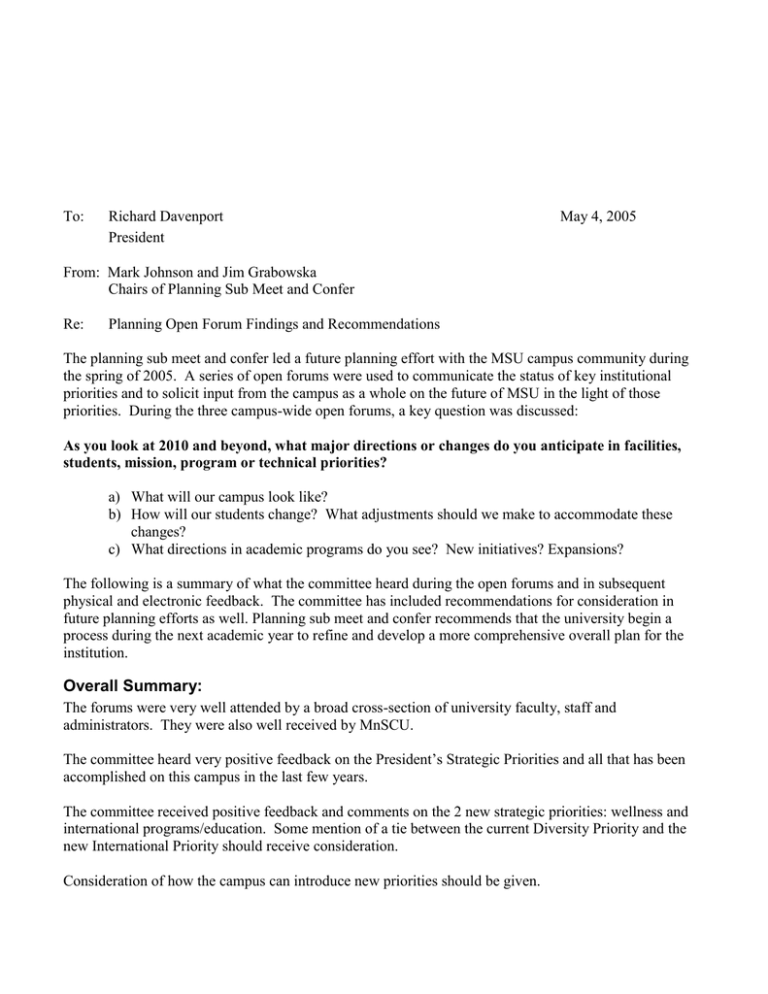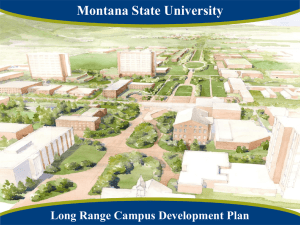To: Richard Davenport May 4, 2005 President
advertisement

To: Richard Davenport President May 4, 2005 From: Mark Johnson and Jim Grabowska Chairs of Planning Sub Meet and Confer Re: Planning Open Forum Findings and Recommendations The planning sub meet and confer led a future planning effort with the MSU campus community during the spring of 2005. A series of open forums were used to communicate the status of key institutional priorities and to solicit input from the campus as a whole on the future of MSU in the light of those priorities. During the three campus-wide open forums, a key question was discussed: As you look at 2010 and beyond, what major directions or changes do you anticipate in facilities, students, mission, program or technical priorities? a) What will our campus look like? b) How will our students change? What adjustments should we make to accommodate these changes? c) What directions in academic programs do you see? New initiatives? Expansions? The following is a summary of what the committee heard during the open forums and in subsequent physical and electronic feedback. The committee has included recommendations for consideration in future planning efforts as well. Planning sub meet and confer recommends that the university begin a process during the next academic year to refine and develop a more comprehensive overall plan for the institution. Overall Summary: The forums were very well attended by a broad cross-section of university faculty, staff and administrators. They were also well received by MnSCU. The committee heard very positive feedback on the President’s Strategic Priorities and all that has been accomplished on this campus in the last few years. The committee received positive feedback and comments on the 2 new strategic priorities: wellness and international programs/education. Some mention of a tie between the current Diversity Priority and the new International Priority should receive consideration. Consideration of how the campus can introduce new priorities should be given. Primary Recommendations: 1. The Gamma Draft Strategic Planning Document should move out of draft with some minor revisions. It is a valuable document that articulates the overall institutional direction and brings together all the key priorities. This document needs to be thoroughly disseminated to the entire MSU community both internally and externally. a. The alignment of Vision, Mission, Values and Priorities should be emphasized in this document. b. A new brochure would be a valuable communication tool to both internal and external constituents in regard to the university's Strategic Plan and Priorities. 2. Funding of the strategic priorities and consideration for funding of key goals and initiatives must continue. A plan to move the current priorities to a sustainable funding model should be implemented. See note A. Secondary Recommendations (based on the forum feedback and aligned under the appropriate question): As you look at 2010 and beyond, what major directions or changes do you anticipate in facilities, students, mission, program or technical priorities? a. What will our campus look like? 1. The campus should move toward an energy sustainable & environmentally sensitive campus including consideration for renewable energy, energy independence, open space, green space and light free zones and include nutritional food offerings. 2. The current student housing plan that concentrates residential life near the campus core should move forward and include continued emphasis on residential learning communities. 3. The university should continue the move to a more pedestrian campus. 4. There is a need for more classroom space and a more modular setup in these classrooms to accommodate new ways of instruction (such as group and collaborative work). More overall space for offices and meeting rooms should be considered. 5. The capital campaign should proceed and be supported by the campus. Emphasis on physical space as well as program development should be considered. Page 2 of 5 b. How will our students change? What adjustments should we make to accommodate these changes? 1. The university should continue to review the changing demographics of our students and the unique needs that these students may have. a) Older students as well as older staff/faculty. b) Address changes in the physical, mental, emotional well-being of our incoming students c) Due to decreasing numbers of high school graduates in greater Minnesota, it will be necessary to increase the visibility of the university and focus recruitment efforts in the Twin City metropolitan area. d) The university should consider how it will gain a fair share of transfer students, especially since the community/technical colleges gain in potential as the place of financial choice? e) We should consider how PSEO will work to our advantage as this choice becomes a significant financial option for the first two years of college? f) Underrepresented students, staff and faculty 2. An increased demand for technology and distance education needs to be addressed. As we move to non-traditional classes and delivery, effort should be made to provide standardized course offerings and services to all students. 3. MSU is above national norms in retention of students from the freshman to sophomore year; the university should work to achieve similar results between the sophomore and junior years. 4. Continue work to market the university with a goal to let others know who MSU is and what the university offers Minnesota. 5. In order for MSU to continue to grow the graduate college and provide meaningful experiences for graduate students, an increase in Graduate Assistants and Graduate Assistantships should be continued. 6. We should have further discussions relating costs to value as students experience increased financial pressures. Possible areas of consideration include housing, food, tuition rates and fees. 7. MSU should review all career service offerings to ensure that the students’ needs are met. 8. The university should review how it defines "alumni". a) If in terms of funding the university wants to look externally, who will it talk to? b) And what will the university talk to them about? (on-campus vs. virtual students) c) In terms of program assessment and evaluation, who will the university talk to? Page 3 of 5 9. The university should review how it defines "community". Traditional and nontraditional students, on and off campus, online and in the classroom, living on campus, in the greater Mankato area and even living elsewhere in the world are part of the “community”. a) Community issues vs. campus issues: how will the university handle the needs of immigrant populations, i.e. consideration for the religious practices of our students? b) How will the university work to integrate parents and family in the students' college experience? c) How will the university address concerns about PSEO and high school student enrollment in university level course work? c. What directions in academic programs do you see? New initiatives? Expansions? 1. MSU should continue to pursue the ability to offer Applied Doctorates in selected fields focused on the needs of greater Minnesota. 2. Interdisciplinary Studies need to be streamlined. 3. Assessment or evaluation committees should continue. 4. External Grant opportunities need to be pursued. The university needs to determine how it can position itself to be more competitive in the external grants arena. The first step is to facilitate publication of faculty research. This will also be important as MSU increases its position in graduate education, especially if the university gets into the business of applied doctorate degrees. 5. Create opportunities for our students of color to reach out to students of color in local K-12 schools. This can spread the message of the importance of a college degree to atrisk groups and may lead to local recruitment of diverse students to MSU. Page 4 of 5 Note A. Planning met with the Budget Sub-Meet on April 18, 2005 to discuss sustainable funding for the Strategic Priorities. President Davenport attended the meeting and indicated that what he would like to see is a discussion of what practices and artifacts could be left behind as we move to fund new initiatives, noting that we cannot continue to find funds for new initiatives from a budget that is not growing. Observations made by participants included the need to establish links between Planning and Budget for the future to address the funding issues related to future planning and the need to develop tools of assessment to be applied to funding requests within the Strategic Priorities. The President indicated that no major budget policy changes are anticipated for the coming fiscal year and that a sustainable funding model for successful new initiatives is at least one year away. It was suggested that a charge to establish priorities for initiatives within each Strategic Priority be returned to the respective sub-meets or taskforces so that Planning and Budget may begin to work toward the goal of making institution wide recommendations for the funding of these initiatives. Note B. Planning Sub Meet and Confer members: Michael Fagin, John Frey, Scott Johnson, Sean McGoldrick, Carol Stallkamp, Chris Connolly, Jeff Iseminger, Jim Grabowska, Paul Schwinghammer, Glen Peterson, Maureen Prenn, Lynne Weber, Gregg Marg, Perry Wood, Cindy Janney, Gael Mericle, Mark Johnson, Rose Marie Ley Note C. Websites: http://cio.mnsu.edu/planning/ http://www.mnsu.edu/planning/ Page 5 of 5
